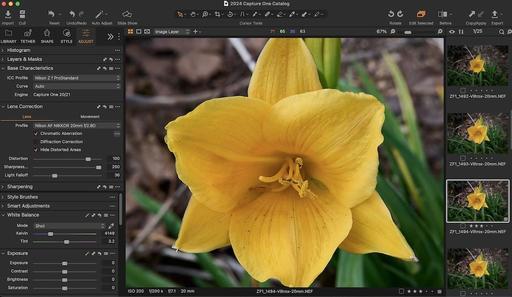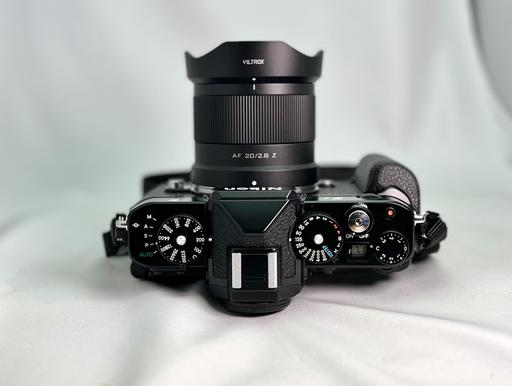This is The Digital Story Podcast #934, Feb. 13, 2024. Today's theme is "The Temptation of Cheap Third Party Lenses." I'm Derrick Story.
Opening Monologue
It's hard to resist the siren call of super-affordable Chinese-made optics. For the price of a polarizer, we can fill gaps in our lens library that we might not otherwise be able to afford. But even at a modest price, do these accessories provide the quality we need for our work? The answer is "yes," and "no." Find out why on today's TDS Photography Podcast. I hope you enjoy the show.
Tune-In Via Your Favorite Podcast App!
Apple Podcasts -- Spotify Podcasts -- Stitcher
Podbean Podcasts -- Podbay FM -- Tune In
The Temptation of Cheap Third Party Lenses
There are lenses that we use all of the time - 24mm, 40mm, 85mm - and lenses that we use every now and then. For our everyday work, I recommend sticking with optics that we know we can depend on, usually manfactured by the camera brand they are being mounted on.
But what about those lenses we only use some of the time? Should we pay a premium for those as well?
I was looking for a super-wide for the Nikon Zf. I wanted an optic that could cover more ground than my current 24mm. The Nikon NIKKOR Z 20mm S with a maximum aperture of f/1.8 has an overall rating of 4.9 and costs $1,046. It is 4.27" long and weighs just over a pound. It uses a 77mm front filter.
The Viltrox 20mm Z has a maximum aperture of f/2.8, no star ratings yet on Amazon, and costs $158. It is 2.7" long, weighs 6.1 ounces, and uses a 52mm front filter.
Lens construction differences between the two optics are different, but not as much as you might think. The Viltrox has 10 elements in 8 groups with 7 aperture blades. The Nikon has 14 elements in 11 groups with 9 aperture blades. Both optics have quiet AF and manual focus, and nano multilayer coating on the elements. And both work well on the Nikon Zf.
We know that the Nikon 20mm performs well. But what about the Viltrox? I did a little testing with it mounted on the Nikon Zf. Here's what I found.
- Autofocusing was quiet and smooth. Feels a tad slower than the Nikon, but very much in the acceptable range.
- Sharpness was very good across the entire frame at f/5.6 and above. At f/2.8 and f/4 sharpness was good, but not as crisp in the corners.
- Strong vignetting apparent at f/2.8. The effect diminished at f/4 and above.
- Close-up performance (7.5") is quite good.
- Lens flare and CA were well controlled.
So, right out of the camera, the Viltrox doesn't compete well against the Nikon. It's a stop slower, doesn't focus as fast, and doesn't perform its best wide open.
But I worked the files a bit in Capture One Pro. Here's what I did.
In Lens Correction, I selected the Nikon AF 20mm f/2.8 D profile. In that same panel, I increased sharpness and compensated for Light Falloff. In the Base Characteristics panel, I used the Nikon Zf Neutral profile. I then processed the image normally including a little devignetting. The finished RAW file looked very good.
The bottom line here is if you're willing to spend a little time in post-processing massaging the RAW files, you can get good results from the Viltrox 20mm f/2.8. And if you only need a super wide on occasion, then the extra time might be worth it.
However, if you want premium image quality and handling, then the Nikon Z is the superior way to go.
The Viltrox 20mm f/2.8 is available in both Nikon Z and Sony E mounts for $158.
Fujifilm and Skylum are Hosting 50 Free Photo Walks Across the U.S.
You can read the entire article at Petapixel.com.
Skylum, the company behind the Luminar Neo editing platform, and Fujifilm have partnered to host 50 free photo walks across the United States, giving photographers a chance to not only see their local cities in a new light but also try out new Fujifilm gear. The two companies say that this "experimental" new program was developed to inspire photographers to explore various metropolitan cities through their camera lenses on a series of guided photo walks where they will be surrounded by a like-minded community.
As part of the experience, participants will be able to try out Fujifilm's latest cameras and lenses and get face-to-face time with personnel from both companies.
"At almost every event in which Fujifilm participates, we look for an opportunity to integrate photo walks" Victor Ha, vice president of the Fujifilm North America Corporation, Electronic Imaging Division says.
"We see photo walks as incredibly important pieces of the creative process. They're not only a way to build camaraderie among creators, but also to allow them to make compelling images and content in real-world settings. We're excited to collaborate with Luminar Neo on these photo walks and to give local creators the tools needed to share ideas, expertise, and stories with each other, and the world."
The two companies say that regardless of skill level, these photo walks offer a unique chance to improve skills and also connect with the local community. The first photo walks are scheduled to take place in Las Vegas, Dallas, and Salt Lake City in March and the rest will take place throughout the month in cities like Portland, San Francisco, San Diego, Denver, Austin, Clearwater, Detroit, and many others.
The full schedule of events can be found on a dedicated Eventbrite page where registration is free. The company says more locations will be added over the next few days.
Spring in Sedona Photography Workshop
April 16-19, 2024 - TDS photographers return to the greater Sedona, AZ area, but this time during the Spring to view the landscape in a whole new way. We will explore iconic locations, picturesque landscapes, mysterious vortexes, and towns frozen in time from the mining days. What a great way to kick off our 2024 workshop season!
You can learn more and reserve your spot by clicking here. Hope to see you in April!
The OM-1 Mark II: More Camera Than First Meets the Eye
You can read the entire article on FStoppers.com
The OM-1 Mark II has certainly caused a stir. Here's a deep dive into what this camera is all about and why it's another winner and a bigger upgrade than you might first think.
Special Features of the OM-1 Mark II
Upgraded: High Res Shot
This feature takes a series of photos in quick succession and combines them into a single 80-megapixel raw file and JPEG, now with the option of the raw file being 14-bit. That gives three times the number of tones in the image. There is a handheld 50-megapixel version too, taking advantage of the image stabilization.
Upgraded: Live ND Shooting
Saving you from carrying ND filters with you for long exposures, Live ND is an ND filter built into the camera. The OM-1 Mark II now gives up to seven stops, i.e., ND128. Although useful on its own, reducing the amount of gear you need to carry, it can be used in conjunction with an ND filter on your lens, delivering exceptionally long exposures even in bright daylight.New: Live GND Shooting
As an alternative to Live ND, it's now possible to have one, two, or three stops of graduated ND filter applied to raw files and JPEGs by the camera. There are three levels of feathering of the graduation: soft, medium, and hard. You can also change the angle of the graduation.Upgraded: Pro Capture and Blackout-Free Shooting
One of the huge upgrades of this camera is the doubling of the buffer size. If you are not aware of it, Pro Capture continuously buffers images and records the most recent of them when you press the shutter button. With continuous autofocus, the buffering is happening at 50 frames per second (fps), and it will buffer 256 frames. That's 5 seconds' worth of images. In that way, you should never miss a shot when a bird takes to the wing or when the bride kisses the groom.
With single autofocus, the camera records a staggering 120 fps and will buffer 213 shots.
The camera also has improved blackout-free sequential shooting.
Upgraded and New: AI Subject Detection Focusing
Another great option for wildlife photographers is the AI Subject Detection. I have found this excellent for detecting partially hidden birds, obscured by twigs and branches, and for latching onto birds in flight with cluttered backgrounds.
You can now also select individual subjects in crowded scenes. That's not only great for wildlife photographers but also events and wedding photographers, especially as Human Detection has been added. Furthermore, they are all accessible in the same place on the Super Control Panel, which gives quick access to important features.
I haven't tried the vehicular options, but the bird, animal, and the new human detection are outstandingly fast and precise.
Conclusion: Like its predecessor, the OM-1 Mark II is a camera that has continued to break the mold; it's definitely not a clone of every other camera out there, and it's good to see that OMDS are sticking to their guns and providing a product with features that tick the boxes of its user base. Consequently, it's already proving to be a popular choice.
Virtual Camera Club News
The Nimble Photographer Newsletter is now publishing every Thursday. Readers will enjoy a variety of content spanning from short photo essays, to commentary on weekly events, to reviews of the latest and coolest photo gear.
TDS Workshops! - You can sign up for available workshops by visiting The Nimble Photographer. Inner Circle Members receive a 10-percent discount on all events.
Inner Circle Members: A big thanks to those who support our podcast and our efforts! We are having a blast at our new Inner Circle hangout, the private group I've set up at DerrickStoryOnline. We'd love it if you join us. You can become an Inner Circle Member by signing up at our Patreon site. You will automatically be added to the new hangout.
Great Photography Articles on Live View - If you check out our publication and appreciate what you see, be sure to follow us and clap for those authors. You can find us at medium.com/live-view.
If you're interested in writing for Live View, drop me a line at dstory@gmail.com.
The New Donation Kit for Carefree Shipping of Found Film Cameras - If you've discovered a film camera that's no longer being used, our new Donation Kit makes it easy to pack and ship. Just visit the Contact Form on thenimblephotographer.com, click the box next to Donating a Film Camera, and let me know what you have. In your note, be sure to include your shipping address.
Affiliate Links - The links to some products in this podcast contain an affiliate code that credits The Digital Story for any purchases made from B&H Photo and Amazon via that click-through. Depending on the purchase, we may receive some financial compensation.
Red River Paper - And finally, be sure to visit our friends at Red River Paper for all of your inkjet supply needs.
See you next week!
You can share your thoughts at the TDS Facebook page, where I'll post this story for discussion.













